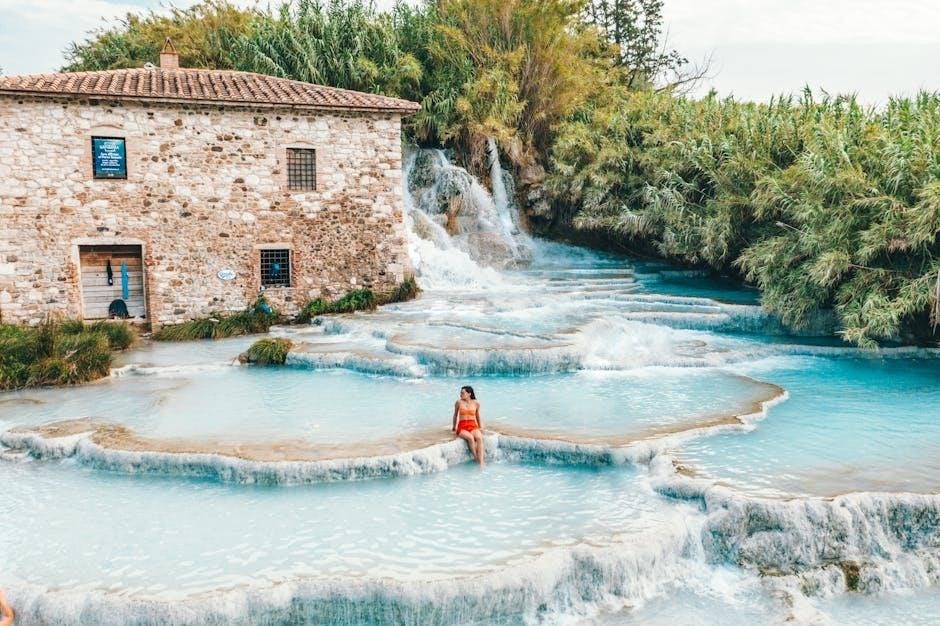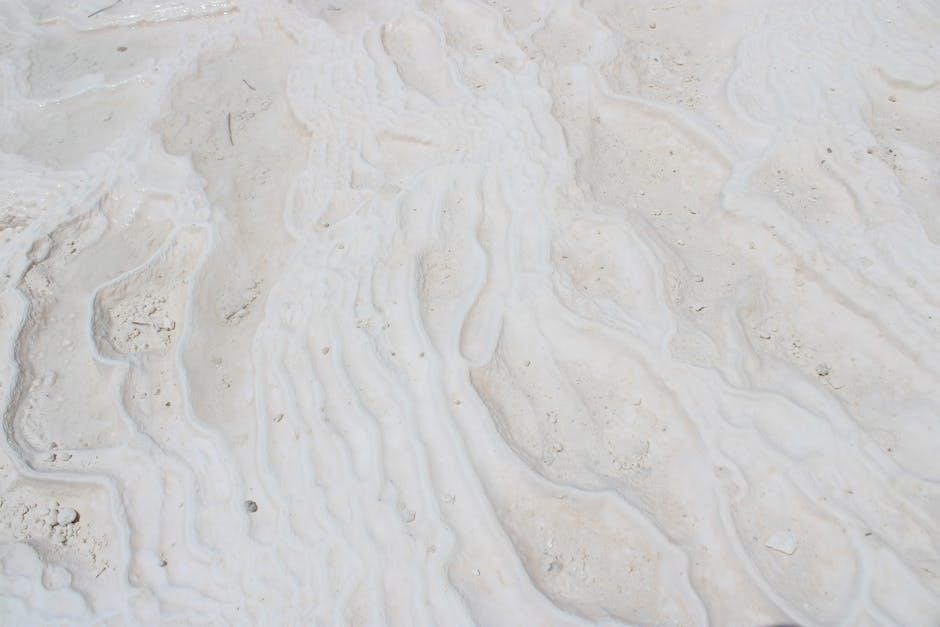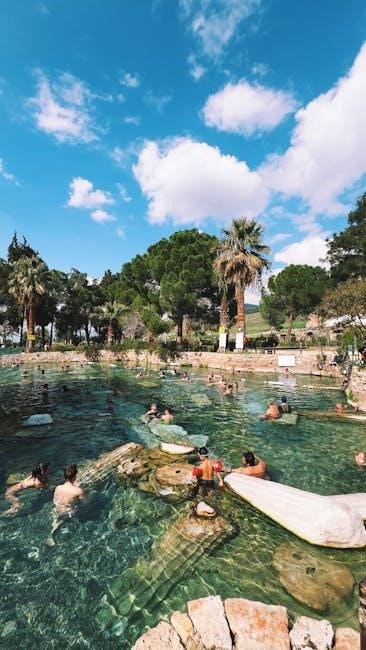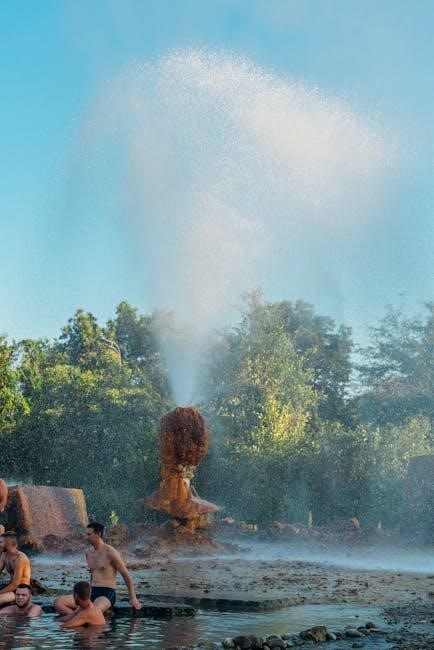Learn to identify and fix common issues in your Hot Spring Spa with this comprehensive guide. From heater problems to water quality, discover DIY solutions and maintenance tips to keep your spa running smoothly. Regular upkeep and quick troubleshooting can extend the life of your hot tub and ensure optimal performance. This guide is your go-to resource for resolving common issues and understanding when professional assistance is needed. Let’s dive in and keep your spa in pristine condition year-round!
Understanding Common Issues in Hot Spring Spas
Common issues in Hot Spring Spas include heater malfunctions, jet operation problems, and electrical system glitches. Blinking lights on the control panel often indicate specific errors, such as a faulty pressure sensor or flow switch. Clogged filters and low water levels can disrupt pump function, while air locks and leaks may cause further damage. Regular maintenance, like cleaning filters and checking wiring connections, can prevent many of these problems. Identifying symptoms early helps resolve issues before they escalate, ensuring your spa remains functional and enjoyable.
Importance of Regular Maintenance
Regular maintenance is crucial for ensuring optimal performance and longevity of your Hot Spring Spa. Cleaning filters, checking electrical connections, and monitoring water quality helps prevent issues like clogged jets and bacterial growth. Dirty filters can harbor bacteria, reducing water clarity and filtration efficiency. Consistently maintaining your spa prevents unexpected breakdowns, extends its lifespan, and ensures a safe, enjoyable soaking experience. Early detection of worn or damaged parts can save costs and enhance overall functionality, keeping your spa in top condition for years to come.
Basic Tools and Resources Needed for Troubleshooting
For effective Hot Spring Spa troubleshooting, gather essential tools like a multimeter, screwdrivers, and a GFCI tester. Keep your spa’s service manual handy for reference. Ensure you have replacement parts such as filters and O-rings. Familiarize yourself with the control panel and error codes. Access to a troubleshooting chart or guide is crucial for diagnosing issues quickly. Regularly cleaning tools and having a supply of water test strips will help maintain water quality and prevent system malfunctions. Proper resources can make resolving spa issues faster and more efficient.

Heater-Related Problems
Heater issues in your Hot Spring Spa can disrupt relaxation. Addressing no heat, temperature fluctuations, and error codes promptly ensures optimal performance. Regular maintenance is key to preventing these problems and extending the lifespan of your spa’s heating system. Always refer to your spa’s manual for specific troubleshooting steps and guidelines to resolve heater-related concerns effectively.
No Heat or Low Heat Output
If your Hot Spring Spa isn’t heating or has low heat output, start by checking the power supply and ensuring the thermostat is set correctly. A tripped breaker or blown fuse could be the culprit. Next, inspect the heater element for damage or corrosion. Use a multimeter to test for continuity if unsure. Also, verify the flow switch isn’t stuck, as restricted water flow can prevent heating. Clean or replace clogged filters, as dirty ones can reduce water flow. Ensure the water level is adequate, as low levels may disable the heater. If issues persist, reset the spa or consult a professional for advanced diagnostics. Regular maintenance can prevent these problems and ensure your spa operates efficiently.
Temperature Fluctuations
Experiencing inconsistent water temperatures in your Hot Spring Spa? Start by checking the thermostat to ensure it’s set correctly. A faulty temperature sensor or malfunctioning heater relay could cause fluctuations. Verify the control panel for error codes, as these may indicate sensor issues. Also, inspect the temperature probe for proper function and ensure the spa is operating in the correct mode (e.g., not in economy or sleep mode). Power fluctuations or loose wiring connections can also affect temperature stability. Resetting the system or consulting a professional may be necessary if the issue persists.
Heater Error Codes and Solutions
When your Hot Spring Spa displays heater-related error codes, it’s crucial to address them promptly. Common codes like E01 (temperature sensor issue) or E02 (high temperature fault) indicate specific problems. For E01, check the sensor connections and ensure proper water flow. If E02 appears, verify the thermostat settings and inspect for blockages. For E03 (communication error), reset the system or consult a professional. Always refer to your manual for code meanings and solutions to restore heating functionality and maintain your spa’s performance. Timely fixes prevent further damage and ensure safe operation.

Jets and Pumps Malfunctioning
Identify and resolve issues with your Hot Spring Spa jets and pumps. Weak jet performance, pump malfunctions, and strange noises can disrupt your spa experience. Regular maintenance and quick troubleshooting ensure optimal function. Address these problems promptly to keep your spa running smoothly.
Weak or Surging Jet Operation
Weak or surging jet operation in your Hot Spring Spa can be caused by low water levels, clogged filters, or closed valves. Check if the water level is below the jets and refill if necessary. Inspect and clean the filter to ensure proper water flow. Additionally, ensure the Comfort Control lever is fully open. If issues persist, verify pump operation and check for air locks in the system. Regular maintenance can prevent these problems and keep your jets functioning smoothly.
Pump Not Turning On
If the pump in your Hot Spring Spa isn’t turning on, check the power supply first. Ensure the GFCI breaker is reset and all wiring connections are secure. Verify that the control panel is functioning correctly and the spa is set to the proper mode. Low water levels or air locks can also prevent the pump from operating. If the issue persists, consult your owner’s manual or contact a certified technician to diagnose and repair any internal pump malfunctions or electrical issues.
Strange Noises from the Pump
Unusual pump noises in your Hot Spring Spa can signal underlying issues. Common causes include clogged filters, air locks, or low water levels. Start by inspecting and cleaning the filter to ensure proper water flow. Check the water level and top it off if necessary. Air locks can often be resolved by bleeding the system. If the noise persists, it may indicate a failing pump motor or worn bearings, requiring professional inspection and repair to prevent further damage.

Electrical System Issues
Address electrical problems promptly to ensure safe and reliable spa operation. Common issues include tripped breakers, blinking control panel lights, and power resets. Always disconnect power before diagnosing.
Blinking Lights on the Control Panel
Blinking lights on the control panel indicate specific issues. A red light often signals a heater problem or high temperature. A green light might indicate a power or reset issue. To resolve, turn off the spa’s power at the breaker for 1 minute, then restart. For 240V spas, reset the 20A breaker before the 30A. If issues persist, consult your Hot Spring Spa manual or contact professional service. Always ensure safety by disconnecting power before further troubleshooting.
Tripped Circuit Breakers
If the circuit breaker trips, it may indicate an electrical overload or a short circuit. First, ensure the spa is turned off. Check the GFCI breaker and reset it if necessary. Verify all wiring connections for damage or corrosion. Overloaded circuits can also cause tripping, so ensure the spa is on a dedicated 20A or 30A line. If the issue persists, contact a licensed electrician. Always prioritize safety when handling electrical systems to avoid further complications and ensure your spa operates smoothly.
Power Reset Procedures
Resetting your Hot Spring Spa can resolve many electrical issues. Start by turning off the power at the breaker for 1 minute. For 240V spas, switch off the 20A breaker, wait, then reset the 30A breaker. For 120V models, simply toggle the breaker. After resetting, turn the power back on and test the system. This procedure often clears minor glitches without needing professional help. Always ensure safety by following proper shutdown and startup sequences to maintain your spa’s optimal performance and longevity.

Control Panel and Display Problems
Hot Spring Spa control panels may show issues like blinking lights or unreadable displays. Check for loose connections, reset the system, or replace faulty sensors to resolve these problems quickly.
Display Shows Dashes or Unreadable Characters
If your Hot Spring Spa display shows dashes or unreadable characters, it may indicate a communication error or faulty sensor. First, try resetting the spa by turning off the power at the breaker for 10 minutes. If the issue persists, inspect the wiring connections for corrosion or damage. Ensure all sensors, like the pressure sensor, are functioning properly. In some cases, replacing the faulty sensor or the display itself may be necessary. Always consult your user manual or contact a professional if the problem remains unresolved.

- Reset the spa by turning off power for 10 minutes.
- Check wiring connections for damage or corrosion.
- Test and replace faulty sensors or the display if needed.

Pressure Sensor Malfunction
A malfunctioning pressure sensor in your Hot Spring Spa can trigger error codes like FL1, indicating a flow switch issue; This often occurs due to a dirty filter or air lock in the system. To resolve this, clean or replace the filter and ensure proper water flow. Check for any blockages in the pipes and verify that the water level is adequate. If the problem persists, reset the spa by turning off the power for 10 minutes. If the issue remains, professional servicing may be required to replace the faulty sensor.
- Clean or replace the filter to ensure proper water flow.
- Check for blockages or air locks in the system.
- Reset the spa by turning off power for 10 minutes.
FL1 Error Code and Flow Switch Issues
The FL1 error code indicates a flow switch malfunction, often caused by a dirty filter or air lock in the system. This occurs when the flow switch is stuck open, preventing proper water flow. To resolve this, clean or replace the filter, check for blockages, and ensure the water level is adequate. Resetting the spa by turning off the power for 10 minutes may also clear the error. If the issue persists, professional servicing may be required to replace the faulty flow switch.
- Check and clean or replace the filter to restore proper flow.
- Inspect the system for blockages or air locks.
- Reset the spa by turning off power for 10 minutes.
Water Quality and Filtration
Maintaining clean water is essential for your spa’s longevity and user health. Regular filter cleaning and proper sanitization prevent bacteria growth and ensure clear water. Monitor chemical levels to avoid imbalances that can damage equipment or irritate skin. Replace filters as recommended and test water quality weekly for optimal results. A well-maintained filtration system keeps your spa safe and enjoyable for years to come.
Cloudy or Discolored Water
Cloudy or discolored water in your Hot Spring Spa can indicate poor filtration or chemical imbalances. Check and clean your filters regularly, as clogged filters fail to remove debris. Adjust sanitizer levels, ensuring proper bromine or chlorine levels. Shock the water if necessary to eliminate contaminants. If the issue persists, test for pH and alkalinity levels, as imbalances can discolor water. Regular maintenance and chemical adjustments will restore clarity and safety to your spa water. Always follow manufacturer guidelines for chemical usage.

Clogged or Dirty Filters
Clogged or dirty filters can disrupt your Hot Spring Spa’s performance by restricting water flow. Clean your filters every 4 weeks by rinsing with a garden hose and soaking in a filter cleaner. Replace filters every 1-2 years, depending on usage. Regular maintenance ensures optimal water circulation, heating efficiency, and filtration. Neglecting filter care can lead to system malfunctions, such as the FL1 error code or reduced jet performance. Keep your spa running smoothly by prioritizing filter upkeep.
Sanitization and Chemical Imbalance
Proper sanitization and chemical balance are crucial for your Hot Spring Spa’s health and safety. Imbalanced chemicals can cause cloudy water, skin irritation, or damage to spa components. Regularly test and adjust sanitizer levels, such as bromine or chlorine, to maintain optimal ranges. Shocking the water weekly helps eliminate contaminants. If the FL1 error code appears, it may indicate a flow switch issue due to poor water quality. Always follow the manufacturer’s guidelines for chemical usage to ensure a safe and enjoyable soaking experience.
Other Common Issues
Beyond major systems, issues like low water level, air locks, or leakage can disrupt your spa experience. Regularly check water levels, inspect for leaks, and purge air from pipes to maintain optimal performance.
Low Water Level
A low water level in your Hot Spring Spa can cause the heater to overwork and potentially fail. Check the water level regularly and refill as needed to ensure it stays above the jets but below the pillows. Evaporation or excessive use may lead to low levels. Always add water carefully to avoid sudden changes in temperature or chemistry. If the level drops too low, turn off the spa immediately to prevent damage to the heating elements. Regular monitoring is key to maintaining optimal performance and longevity of your spa.
Air Locks in the System
Air locks in your Hot Spring Spa occur when air enters the plumbing, disrupting water flow. This can cause weak jet performance or heater issues. To resolve, turn off the power, wait a few minutes, and restart the spa. If the problem persists, check for blockages in the pipes or jets. Ensure the water level is adequate, as low levels can contribute to air locks. Regularly draining and refilling the spa can help prevent this issue. Addressing air locks promptly ensures optimal performance and longevity of your spa system.
Leakage or Water Loss
Leakage or water loss in your Hot Spring Spa can lead to operational issues and damage. Regularly inspect the plumbing connections, jets, and gaskets for signs of wear or cracks. Check the pump and valves for leaks, as these are common sources. If water loss persists, apply food coloring to the water to identify the leak’s location. Addressing leaks promptly prevents further damage and maintains your spa’s efficiency. Ensure all connections are tight and consider replacing worn-out seals to resolve the issue effectively.
Advanced Troubleshooting Techniques
Inspect wiring connections for corrosion or damage and test the GFCI breaker. Drain and refill the spa to resolve persistent issues. Advanced diagnostics may require professional servicing.
Checking Wiring Connections
Inspect all wiring connections for corrosion, damage, or loose terminals. Ensure the GFCI breaker is functioning properly. Turn off power before checking connections. Use a multimeter to verify continuity and voltage. Secure any loose wires and replace damaged components. Corrosion can cause shorts, leading to system malfunctions. After repairs, reset the spa and test operation. If issues persist, consult a professional technician to ensure safety and proper functionality.
Testing the GFCI Breaker
Locate the GFCI breaker in your spa’s electrical system. Press the test button to ensure it trips properly; If it doesn’t reset, check for power issues. After testing, reset the breaker and monitor the spa’s operation. A tripped GFCI indicates a potential ground fault or electrical issue. If it trips repeatedly, inspect for moisture or wiring faults. Always turn off power before handling electrical components. If problems persist, consult a licensed electrician to ensure safety and proper functionality.
Draining and Refilling the Spa
Drain the spa completely using a submersible pump or drain valve. Inspect the interior for debris or stains. Clean the shell and surfaces thoroughly. Refill with fresh water, ensuring the correct level. Add recommended chemicals and test the water balance. Always follow manufacturer guidelines to prevent damage. Regular draining and refilling maintain water quality and prevent bacterial growth. This process is essential for keeping your spa clean and safe for use. Schedule this maintenance every 3-4 months for optimal results.

Maintenance Tips to Prevent Future Issues
Regularly clean filters, monitor water levels, and maintain chemical balance to prevent breakdowns. Schedule professional servicing annually to ensure optimal performance and longevity of your spa system.

Regular Filter Cleaning
Dirty filters can harbor bacteria and reduce water flow, leading to system issues. Clean your Hot Spring Spa filters every 4 weeks by soaking them in a degreaser like BEAR STRIP FILTER. Rinse thoroughly and replace. Regular cleaning ensures optimal water circulation and prevents clogs. If neglected, filters may cause the FL1 error or low water flow. Always check and maintain your filters to keep your spa running smoothly and efficiently.
Monitoring Water Levels
Ensure the water level in your Hot Spring Spa is above the jets but below the pillows. Low water levels can cause air locks or pump malfunctions. Check the level regularly, especially after use, and refill as needed. A stable water level maintains proper circulation and prevents system strain. Always follow the manufacturer’s guidelines for optimal water levels to keep your spa functioning efficiently and safely. Regular monitoring prevents unexpected issues and ensures a consistent spa experience.
Scheduling Professional Servicing
Regular professional servicing is essential for maintaining your Hot Spring Spa’s performance and longevity. Schedule annual check-ups with certified technicians to inspect heaters, pumps, and electrical systems. Professionals can identify and address potential issues before they escalate, ensuring safety and efficiency. This also helps prevent costly repairs and extends the lifespan of your spa. By investing in routine servicing, you can enjoy uninterrupted relaxation and peace of mind, knowing your spa is in top condition.

Leave a Reply
You must be logged in to post a comment.